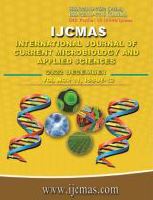


 National Academy of Agricultural Sciences (NAAS)
National Academy of Agricultural Sciences (NAAS)

|
PRINT ISSN : 2319-7692
Online ISSN : 2319-7706 Issues : 12 per year Publisher : Excellent Publishers Email : editorijcmas@gmail.com / submit@ijcmas.com Editor-in-chief: Dr.M.Prakash Index Copernicus ICV 2018: 95.39 NAAS RATING 2020: 5.38 |
In this research work, the effect of biohumus on the agrochemical properties of the soil, fertility and productivity of cucumbers in greenhouse conditions is studied.Since biohumus stores a large amount of nutrients, when added to the soil, it changes the amount of nutrients in the soil. Since biohumus contains trace elements and humic acids, it has an effect of enhancing plant development in cucumber cultivation. Greenhouse soil treated with mineral fertilizer was used as a control option in the experiment. The amount of mineral fertilizer applied to the soil in different years was determined based on the level of nutrient supply of the greenhouse soil as a result of agrochemical analysis. For all options, the plant was fed with the specified amount of mineral and organic fertilizer every 30 days. Application of mineral fertilizers was carried out in two stages. The amount of mineral fertilizers calculated on the basis of the chemical analysis of the soil carried out in the first stage was added. In the second stage, a certain amount of organic fertilizer-biohumus was added according to different options. The mineral fertilizer used in feeding is the same in all options: nitrogen 29 mg/kg (or 7.5 g/m2), phosphorus (P2O5) 19.5 mg/kg (or 5.0 g/m2) and potassium (in terms of K2O) was equal to 23.5 mg/kg (or 6.0 g/m2). Mineral fertilizers were given in the form of ammonium nitrate (22.0 kg/ha), double superphosphate (25 kg/ha) and potassium chloride (11 kg/ha). Comparing the amount of NPK determined after feeding for each option with the amount of NPK before feeding in these options shows the increase in the amount of nutrients in 2019-2021: N-1.2-1.7; P-1.2-2.0; It shows that K–1.2-2.3 times. This mainly corresponded to options 5-8, where feeding with biohumus in the amount of 1.0 kg/m2 was carried out in several stages. According to option 5, the amount of nitrogen in the soil increased from 50 mg/kg to 90 mg/kg, the amount of phosphorus from 53 mg/kg to 101 mg/kg, and the amount of potassium from 49 mg/kg to 66 mg/kg was observed in the 3rd year. In option 9, where 4.0 kg/m2 of biohumus was used under the plow, at the end of the experiment, the amount of NPK in the soil of the experimental plot decreased from the optimum. At the end of the experiment, a significant decrease in NPK was observed in the soil of the site where manure was used at the rate of 2 kg/m2 for feeding. As a result of intensive use of the soil in greenhouse conditions, it was observed that the amount of mineral substances necessary for the development of the plant, especially micro- and macroelements in the mobile form, in the soil of the control option, where only mineral fertilizer was used, was significantly reduced. Usually, in such cases, it is required to use high-quality mineral fertilizers and other chemical compounds in order to obtain a high yield under closed soil conditions. As a result, an excess amount of harmful chemicals accumulates in the crop. The use of biohumus during feeding prevents such unpleasant situations.
 |
 |
 |
 |
 |